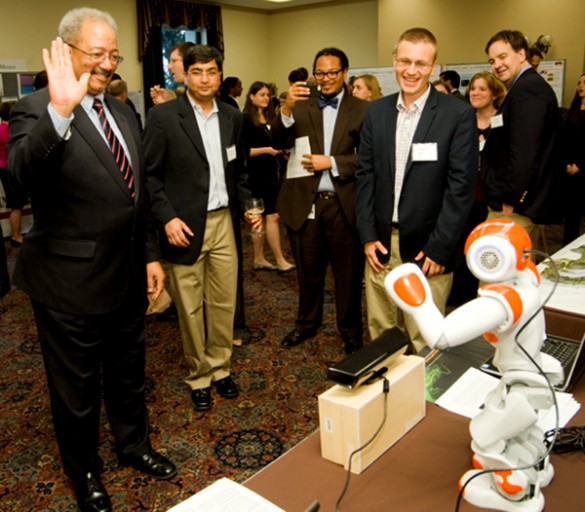
On May 7, Russell the Robot was engaging the movers and shakers on Capitol Hill.
Normally, the two-foot humanoid robot acts as the front man for ARIA, an elaborate system of cameras, sensors and computers developed at Vanderbilt that helps young children diagnosed with autism spectrum disorder (ASD) learn basic social skills.
In this case, Russell was featured at the 20th annual Coalition for National Science Funding (CNSF) exhibition and reception, a major event held to encourage Congress to continue its support for the National Science Foundation. The American Psychological Association and Vanderbilt sponsored the robot’s appearance in order to showcase the role that psychology can play in solving major societal and health problems.
The wizards behind the screen who developed Russell and ARIA (Adaptive Robot-Mediated Intervention Architecture) are Professor of Mechanical Engineering Nilanjan Sarkar and Zachary Warren, associate professor of pediatrics, psychiatry and special education, who directs the Treatment and Research Institute for Autism Spectrum Disorders at the Vanderbilt Kennedy Center.
The initial funding for the project came from a Kennedy Center discovery grant. This gave Sarkar and Warren the foundation they needed to compete successfully for the NSF grant which supported the development of ARIA and enabled the experiments which showed children with ASD pay more attention to the robot than they do to human therapists and accurately follow its instructions during sessions designed to teach critical communication skills.
In addition to the hundreds of legislative and executive branch staff in attendance, eight members of Congress stopped by to interact with Russell and talk with the Vanderbilt professors: Reps. Joyce Beatty (D-OH), Chaka Fattah (D-PA), Rush Holt (D-NJ), Daniel Lipinski (D-IL), Jerry McNerney (D-CA), James Moran (D-VA), Mark Takano (D-CA) and Paul Tonko (D-NY).
Warren and Sarkar walked the representatives through a demonstration with Russell in which they were asked to follow oral directions and mimic movements, behaviors that children diagnosed with ASD find particularly challenging.
Early data from the NSF-funded research suggest that engaging with Russell, programmed with sophisticated capabilities to continuously track and automatically adapt to children’s behaviors in real-time, both captures children’s attention and improves skills critical to intervening early after an ASD diagnosis.
Earlier in the day, Warren and Sarkar met with Senate and House staff from the Tennessee delegation as well as with staff of members who are active in the Congressional Autism Caucus.
CNSF is an alliance of over 125 organizations united by a concern for the scientific enterprise and a commitment to the nation’s investment in NSF. Since its inception in 1988, the coalition has been an active sponsor of the annual event. This year, more than 35 scientific associations and universities brought scientists to Washington to meet with Congressional offices and display their work at the evening exhibit.